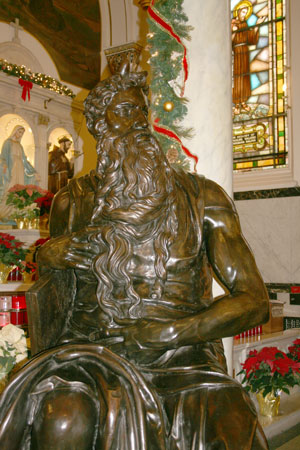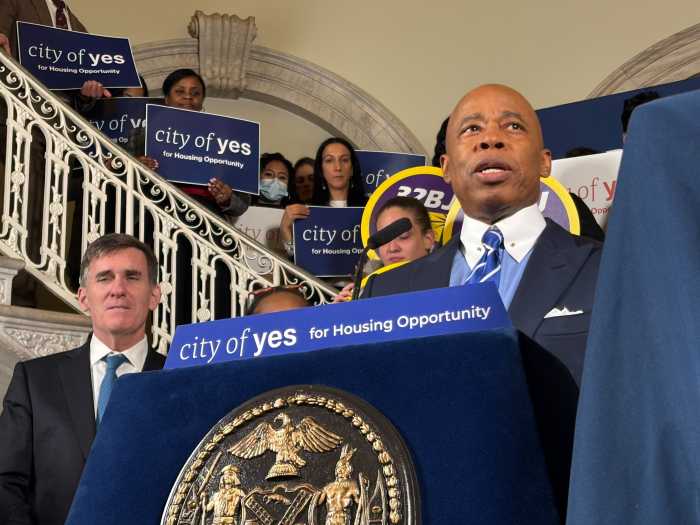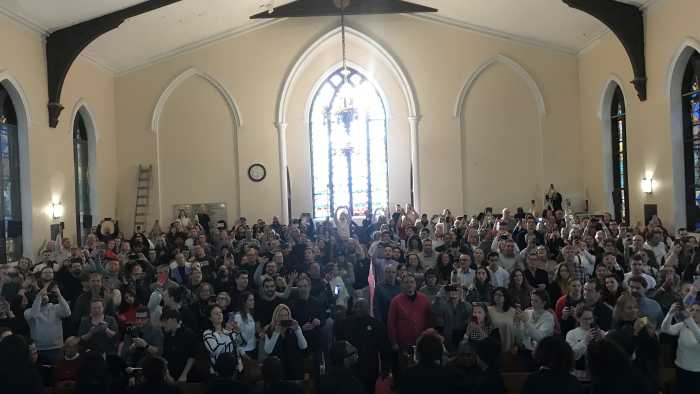 [/media-credit]
[/media-credit]
On Dec. 1, the first official casting of “Moses,” made from Michelangelo’s original white marble sculpture, was installed in the sanctuary of the Church of the Most Precious Blood, at 109 Mulberry St. The bronze work, which was produced in the last 50 years, originated from the very first molding of Michelangelo’s famed sculpture, which is part of the elaborate tomb of Pope Julius II in San Pietro in Vincoli Church in Rome.
The majestic bronze, crafted to the exact dimensions of the original “Moses” by the Chiurazzi Foundry in Italy, depicts a horned, long-bearded Moses who, having just descended Mt. Sinai, is bearing the Ten Commandments down to the Jews.
“The work of art itself is deemed one of the great works of art in the history of the world,” said Chuck Huller, owner of SPQR, a New York-based art-brokerage firm. “It has not only tremendous historical significance, it has what they called ‘implied movement’ — one motion stopping and another about to begin — as well as beauty, form and line.”
The “Moses” replica, appraised at $8.5 million and on sale for just under $4 million, is on loan to Most Precious Blood until next April 1, after which Huller intends to sell it to a philanthropist who would donate it back to the church for a period of time thereafter.
Obtaining the proper permitting from New York City delayed the intended installation of the statue in the church by a couple of weeks, according to Huller. But, in the end, it worked out for the best.
“A lot of good came from a little bad: Instead of getting it for a month, we were able to secure it for four months,” he said.
The day the replica arrived from Washington, D.C., where it was temporarily on display at the Italian Embassy, Huller meticulously prepped “Moses” for public viewing, polishing it with brown shoe polish for five-and-a-half hours. Huller and the church parishioners have e-mailed more than 500 organizations affiliated with the Catholic Archdiocese of New York to spread the word of the statue’s guest appearance.
Huller, whose grandfather moved to the U.S. in the early 1900s from Sicily, feels privileged to have helped get the statue to a church in Little Italy.
“To bring something like this, a bastion of the Neapolitan community, to this church, would have made him smile,” said Huller of the great Italian Renaissance artist.
“It’s exciting. It’s probably right up to par with Father Fabian first coming here about 18 years ago,” said Ralph Tramontana, president of the Little Italy Merchants Association. He was referring to the church’s pastor, Father Fabian Grifone.
Tramontana married and christened his children in the Church of the Most Precious Blood.
Tramontana, owner of Sambuca’s Cafe next door, is hoping the statue will attract the additional visitors he believes the church is in “desperate” need of.
“I consider Little Italy going through a renaissance right now, and ‘Moses’ is from the Renaissance period,” Tramontana said. “It will hopefully bring New Yorkers out to see it and experience Little Italy.”
The cast of the legendary statue has already increased the numbers of visitors to the church on weekends by 50 to 75 percent, according to Father Fabian.
“Now, we’re getting 400, 500, 600 people coming in on Saturday and Sunday,” he said.
Catching a glimpse of the iconic statue in Little Italy is the “next best thing” to visiting the original “Moses” in Rome, the father noted.
“Anyone who knows the existence of Michelangelo and is a devoted follower of art would make a big mistake by not visiting the statue,” he said.
Grifone is now partnering with the Italian Embassy in Washington to organize a blessing ceremony and dinner celebrating the statue’s arrival, to be held sometime in the coming weeks.
As for purchasers of the remarkable bronze work, Huller has his eyes on philanthropists of the likes of Mexican billionaire business magnate Carlos Slim, who previously purchased an original casting of Michelangelo’s “Pietà.”
“What I’d like to do,” Huller said, “is try to persuade the buyer to lend it to us…and, in exchange, get them a tax deduction in the next few years.”
Father Fabian said he was delighted to hear the church might be able to hold on to the statue for a while longer.
“It’d be foolish not to want it here.”
“I’d love for that to happen,” said Tramontana of the prospect. “It would be nice to build interest around the statue for the future.”




































